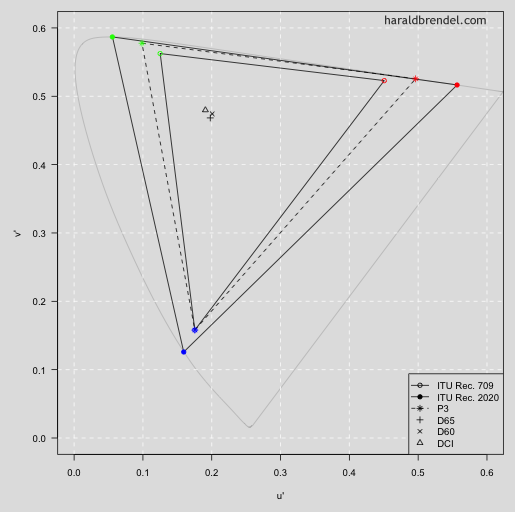ICC Profiles
Download a zip archive that contains ICC profiles for color spaces used in video and motion-picture productions.
The archive contains the following files
- P3D60.icc
- P3D65.icc
- P3DCI.icc
- Rec2020-Rec1886.icc
- Rec709-Rec1886.icc
Usage
The typical workflow in video or motion-picture is not color-managed. People rely on the calibration of a display or of a projector. Professional displays can be adjusted to meet calibration targets within small tolerances. When the same image data is sent to two well-calibrated displays, the images will match.
You can use the profiles to tag RGB images that have been created and viewed on a reference display or on a digital projector. If you view the images in a color-managed application, it can recreate the original image even if your desktop monitor is not adjusted to the same color space as the reference display.
Color Spaces
Three color spaces are commonly used in video and motion-picture productions: ITU Rec. 709, ITU Rec. 2020, and DCI. The figures show the color spaces in the CIE xy and in the CIE 1976 UCS diagram, respectively.
The white point of the colorspaces defined in Rec. 709 and Rec. 2020 is D65. The XYZ encoding for digital cinema allows a variable white point. I provide three different profiles for the digital cinema P3 color space with white points of D65, D60, and DCI.


ITU Rec. 709
The normative reference is ITU-R BT.709: Parameter values for the HDTV standards for production and international programme exchange. A common misconception is that the same standard defines the transfer curve of the display. That didn't happen, however, until the following recommendation was released: ITU-R BT.1886: Reference electro-optical transfer function for flat panel displays used in HDTV studio production.
ITU Rec. 1886 says that the reference EOTF for displays used in HDTV production and programme interchange should be
a power function with an exponent ("gamma") of 2.4. Exactly this is assumed in the provided profile: a display that has the color primaries specified in ITU Rec. 709 and that has a gamma of 2.4.
ITU Rec. 2020
The normative reference is ITU-R BT.2020: Parameter values for ultra-high definition television systems for production and international programme exchange.
Rec. 2020 assumes that the encoding function of image sources is adjusted so that the final picture has the desired look, as viewed on a reference monitor having the reference decoding function of Recommendation ITU-R BT.1886.
The introduction states that if it is shown that an alternative electro-optical transfer function (EOTF) will provide significant benefits without also imposing significant disadvantages, then this Recommendation should be extended to enable use with an improved EOTF.
For now, I therefore assume that Rec. 2020 displays have a gamma of 2.4. That's the reason I named the profile Rec2020-Rec1886.icc.
P3
The document SMPTE RP 431-2:2011 D-Cinema Quality — Reference Projector and Environment defines the minimum gamut for a Reference Projector
. For historic reasons this color space is called P3. The document isn't freely available. Before standardization by SMPTE the specification was established by the Digital Cinema Initiatives (DCI).
The same document specifies the transfer function to be a power function with an exponent of 2.6.
The provided DCI profiles are supposed to be used with RGB images created and viewed on a display or on a digital projector that has the aforementioned gamut and transfer function. The three profiles assume the display/projector is balanced to one of the following white points, respectively.
- D65
- This is the white point used by the video color spaces Rec. 709 and Rec. 2020. The chromaticity coordinates are $nobreaks('x = 0.3127') and $nobreaks('y = 0.3290').
- D60
- This white point has a correlated color temperature of 6000K. The chromaticity coordinates are $nobreaks('x = 0.32168') and $nobreaks('y = 0.33767').
- DCI
- This is the original white point for the digital cinema reference projector. The point lies above the daylight locus. The chromaticity coordinates are $nobreaks('x = 0.314') and $nobreaks('y = 0.351').
I know there are some misunderstandings lurking and I want to make this perfectly clear. The profile DCID65.icc, for example, is for images that have been displayed on a projector balanced to D65. The RGB signal (1,1,1) produces D65.
Technical Details
The ICC V4 profiles were created using a slightly modified version of Little CMS . The modification was made to make sure the sum of the tristimulus values of the colorants yields exactly the tristimulus values of the media white point.
In all profiles the media white point is D50, which has the XYZ tristimulus values (0.9642, 1, 0.82491). Using the original Little CMS software produces a Rec. 2020 profile, for example, where the sum of the colorants is (0.96419, 0.99998, 0.82489). Accordingly, a conversion of RGB (1,1,1) to Lab yields (99.99941, -0.00009, 0.00022).
The reason for this isn't an error in the Little CMS software but rather the fact that an ICC profile encodes all values as 16 bit digital numbers. This limited precision can cause small errors. My modification ensures that the sum of the encoded colorant values matches the encoded media white point. I don't know if this is really of any practical relevance. I could not find any problems in applications like Photoshop using profiles created with the original Little CMS software. But when I opened the profiles in Matlab and carried out the calculations mentioned above, I encountered the small deviations from the expected values. I found a description of the same issue at Nine Degrees Below.

